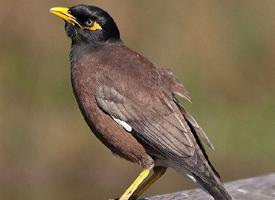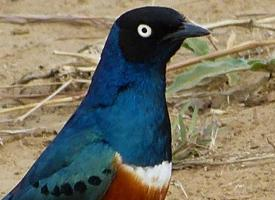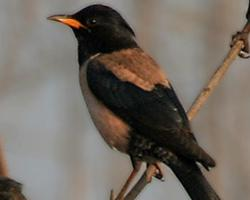
Greutăți și măsuri
| Lungime | 25 cm |
|---|
Starea de conservare
| Amenințat |
Descrierea animalului
The Common Myna, scientifically known as Acridotheres tristis, is a member of the starling family Sturnidae. This bird species is native to Asia, with its range extending from Iran and Kazakhstan to Southeast Asia and throughout the Indian subcontinent. Over the years, the Common Myna has been introduced to many parts of the world, including Australia, New Zealand, and South Africa, where it has adapted well to both urban and rural environments, often becoming a prominent invasive species.Physical Description:
The Common Myna is a medium-sized bird, measuring about 23 cm in length and weighing between 80 to 140 grams. It possesses a sleek body with a brownish body, contrasting sharply with its bright yellow beak and legs. The head, throat, and upper breast are black, with a distinctive white patch on the wings that is visible during flight. The bird's eyes are encircled with a patch of bare yellow skin, which is particularly striking. Its tail is short and square, and the strong legs are adapted for walking and hopping rather than perching, which is typical behavior observed in mynas.
Behavior and Ecology:
Common Mynas are highly adaptable and can live in a wide range of habitats, including open woodlands, grasslands, cultivated areas, and urban environments. They are omnivorous, feeding on a diet that includes insects, fruits, seeds, and occasionally, small vertebrates and human scraps. This opportunistic feeding behavior has allowed them to thrive in urban areas where food sources are abundant.
Mynas are known for their incredible vocal abilities, capable of producing a wide range of sounds, including whistles, squawks, and even imitations of human sounds. They are highly social birds, often seen in pairs or small flocks, and are known to aggressively defend their territory against intruders.
Reproduction:
The breeding season of the Common Myna varies geographically, but it typically nests during the warmer months. Mynas are cavity nesters, utilizing natural cavities in trees or cliffs, as well as man-made structures like buildings and nest boxes. The female usually lays 4 to 6 eggs, which are incubated for about 13 to 18 days. Both parents are involved in feeding and caring for the young, which fledge about three weeks after hatching.
Conservation Status:
The Common Myna is listed as Least Concern by the International Union for Conservation of Nature (IUCN), reflecting its wide distribution and large population size. However, in areas where it has been introduced, it is often considered a pest due to its competition with native species for resources and its potential to spread diseases. Various control measures have been implemented in some regions to manage its population.
In conclusion, the Common Myna is a highly adaptable and intelligent bird species with a significant presence across the globe. While it is admired for its adaptability and vocal abilities, it also poses challenges in areas where it has been introduced, leading to complex conservation and management issues.
Animale similare
Fotografii noi cu animale
Top 10 animale
- Dolphin gull (Leucophaeus scoresbii)
- Diana monkey (Cercopithecus diana)
- Moustached guenon (Cercopithecus cephus)
- Galápagos tortoise (Geochelone nigra complex)
- Stone loach (Barbatula barbatula)
- Japanese macaque (Macaca fuscata)
- Greek tortoise (Testudo graeca)
- Russian tortoise (Testudo horsfieldii)
- Common flying dragon (Draco volans)
- Galápagos penguin (Spheniscus mendiculus)


